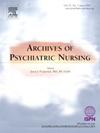Determination of cyberchondria levels of late adolescents and the factors affecting these levels
IF 2.2
4区 医学
Q1 NURSING
引用次数: 0
Abstract
Objectives
Cyberchondria refers to the excessive and repetitive seeking of online health information. Higher levels of cyberchondria can lead to increased stress and anxiety in adolescents, trigger compulsive behaviors, and impact daily activities. This study aims to determine the levels of cyberchondria among late adolescents and the factors affecting these levels.
Methods
A cross-sectional, descriptive study was conducted between December 2022 and February 2023 with 300 nursing students from the Faculty of Health Sciences at a foundation university in Istanbul. Data were collected using a structured Data Form and the Cyberchondria Severity Scale-Short Form (CSS − 12). Statistical analyses were performed using SPSS, with categorical variables summarized as frequencies and percentages, and continuous variables reported as means and standard deviations. Normal distribution was assessed with the Kolmogorov–Smirnov test.
Results
The research findings indicated that the mean score for cyberchondria among late adolescents was 32.53 ± 8.04. It was observed that older adolescents, those with illiterate fathers, and those who trusted health-related information on the internet tended to have higher cyberchondria scores. However, factors such as gender, mother's education level, presence of a health professional in the family, time spent on the internet, and the presence of a chronic disease in oneself or in the family did not affect cyberchondria levels.
Conclusion
This study found moderate levels of cyberchondria among late adolescents. Pediatric nurses should implement educational programs to help adolescents critically evaluate online health information. Further research is needed to assess the long-term psychological effects and intervention efficacy.
青少年后期网络疑病症水平的测定及其影响因素
目的网络疑病症是指过度、重复地在网上查找健康信息。高水平的网络疑病症会增加青少年的压力和焦虑,引发强迫性行为,并影响日常活动。本研究旨在确定青少年后期网络疑病症的水平和影响这些水平的因素。方法于2022年12月至2023年2月对伊斯坦布尔一所基础大学健康科学学院的300名护理专业学生进行横断面描述性研究。采用结构化数据表和网络疑病症严重程度量表-短表(CSS - 12)收集数据。使用SPSS进行统计分析,分类变量汇总为频率和百分比,连续变量报告为均值和标准差。用Kolmogorov-Smirnov检验评估正态分布。结果调查结果显示,晚清青少年网络疑病平均得分为32.53±8.04分。据观察,年龄较大的青少年、父亲不识字的青少年以及相信互联网上与健康有关的信息的青少年往往有较高的网络疑病得分。然而,性别、母亲的受教育程度、家庭中是否有保健专业人员、上网时间、本人或家庭中是否患有慢性病等因素并不影响上网疑病症水平。结论本研究发现青少年晚期存在中等程度的网络疑病症。儿科护士应该实施教育计划,帮助青少年批判性地评估在线健康信息。需要进一步的研究来评估长期的心理影响和干预效果。
本文章由计算机程序翻译,如有差异,请以英文原文为准。
求助全文
约1分钟内获得全文
求助全文
来源期刊
CiteScore
3.70
自引率
0.00%
发文量
131
审稿时长
160 days
期刊介绍:
Archives of Psychiatric Nursing disseminates original, peer-reviewed research that is of interest to psychiatric and mental health care nurses. The field is considered in its broadest perspective, including theory, practice and research applications related to all ages, special populations, settings, and interdisciplinary collaborations in both the public and private sectors. Through critical study, expositions, and review of practice, Archives of Psychiatric Nursing is a medium for clinical scholarship to provide theoretical linkages among diverse areas of practice.

 求助内容:
求助内容: 应助结果提醒方式:
应助结果提醒方式:


